September 13 - 19, 2020: Issue 466
Linda Haigh
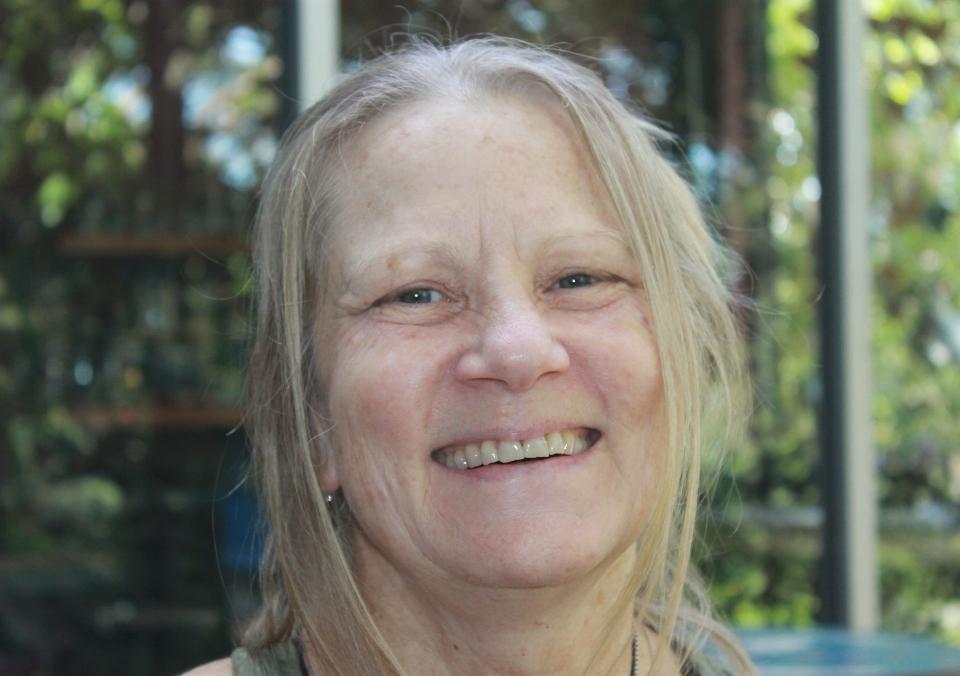
The Founder of the Pittwater Artists Trail is a shy lady, despite fairly crackling with good energy. After running her own therapy practice (deep tissue massage and psychotherapy) for decades, Linda retired from this to be a full-time mum for a decade. Clay then presented itself as a medium which could gracefully absorb Linda’s creative mouldings. Tad Art, a thread that had always been in Linda, waiting to flow, resulted.
This inherent skill to connect, to touch, was added to in fossicking in Nature and connecting with what is found there to create mosaics from bits and pieces found in our environment's own ripples of earth, water, stone, air, metal and fire - something coherent and still fundamental wild evolved, added dimension to tables, to mirror frames.
A twinning of these offered out a third wave - a 'Pebble' series which combines invested hands on sculpting and incorporates a well, a nest, a rock pool of a mosaic in its belly.
Our February 2016 Artist of the Month reminds you of a quick bright eyed bird cloaked with a quiet grace; dual there too. Her pursuit of living a real life reminds you of many streams of wondrous light in every person, a combination coalescing into one pure river. A quality of respectful honouring, of, frankly, loving care, invests her intent, her work, the full petite frame of her being.
Linda is not just a reflection of where she has come from - Linda is a call of what will come too, and recur, as the human spirit 'shifts' to attain its most treasured dreams as a reality.
Last week Linda shared the news that her current co-exhibition at the Be Brave gallery will be her last local one for a while. Tina Berkeley, Be Brave Artspace and Gallery founder, has been 'Keeping the Lights on' throughout current challenges and has a great program of Artists lined up for forthcoming exhibitions, including the current combined one with Earth and Tide from Linda Haigh, and A journey into the interior, showcasing the works of Jackie Fewtrell Gobert until September 20th.
This is great news for local Artisans.
The bad news is that Linda and husband Robin Grille have sold their Avalon Beach home and are going on a little adventure for a while. The original plan was to visit Robin's Uruguay home but with international travel not the best idea at present the family is going to enjoy exploring rural New South Wales instead. They will both be missed!
Linda sent through this message for the community this week:
To leave our community in Avalon, and to say goodbye to the beach I love; the beach that, for two decades, gifted me with weathered, washed-up relics that now embed my sculptures…and to harbour years-ago memories of my daughter and I fossicking for sea glass in the Avalon rockpools…this is a huge moment.
This special place fostered an artist who didn’t know she was one until mid-life. The love I hold for Avalon, and the deep gratitude I feel for having had the privilege of calling Avalon ‘home’, will live in my heart always. - Linda Haigh, September 12, 2020
After her current exhibition this Artists will be On the Road, making Happy Trails, and her unsold work will go into storage - so if you want something, have been eyeing off one of her original creations, now is the time to grab it.
A few insights into the lady herself from her earlier Profile of the Week runs below.
Thank you Linda, for all you have done for our local Arts Community; we can't wait to see what you create next!
Where and when were you born?
I was born in Burbank California, in 1957. I grew up on the East coast in Massachusetts, in a suburb north of Boston. Neither of my parents were American; my mother was German and my dad a Kiwi; they met in Germany after the Second World War, so they raised me and my little sister in a larger paradigm than the standard American nationalism. I never really felt American, I felt like an outsider. In the classroom all through primary school, each day began with saluting the flag and reciting the American Pledge of Allegiance. I hated it, I still revolt at that mindless American patriotism.
I was in high school during the Vietnam War, was full of angst and just not relating to the culture, and felt so alienated to my peers. I wore a bracelet with the name of an "M.I.A." - a soldier Missing In Action. There was an anti-war organisation that would send out metal wrist-bands, each bearing the name of a soldier in Vietnam who was M.I.A. You promised to wear the bracelet until the end of the war...it was like a silent protest.
'Michael Balamotti', I still remember his name. He never returned home.
I couldn't understand why every kid at school didn't wear one. I left home the minute I turned 18, after graduating from high school.
What did you connect to; the landscape; was there some place that had some semblance of a sanctuary for you?
I found refuge in books. We didn’t get a TV until I was 14 because my parents wanted us to read - good call, I still love reading, and writing too. I didn’t have many friends in high school, so, looking back, it was quite a lonely teenage-hood.
It’s interesting that you say ‘sanctuary’ because my first sculpture is called ‘Sanctuary’.
I believe it wasn’t until I was in my early 30’s that I actually started to find myself and know myself and my feelings.
You left school when 18, where did you go?
I was going to go to New Zealand for a year, where my dad was from, because they speak English, and it was a relatively familiar culture for a naive eighteen year old. I went with $200.00 in my pocket! I planned to go for a year and then go back for university.
I travelled and worked, mostly around the north island. Not long after I arrived, in windy Wellington, I started connecting with people and feeling happy and feeling like I belonged. It was my first taste of belonging. People liked me.
I got a job waitressing and another job as a land girl on a farm milking cows and travelled around for two and a half years. I went to university for a year in Wellington, studying philosophy.
After being in New Zealand for a few months the concept of going ‘home’ didn’t enter my head.
I went back to visit my parents, but never to live.
How did you end up in Australia?
When my sister and I were born, Dad had us both naturalised as New Zealanders, which was such good foresight. In those days, the late 1970’s, to get to Australia from New Zealand you didn’t even need a passport, it was like getting on the bus.
So I got on the 'bus', first to the Joh Bjelke police state of 1970's Queensland and then escaped to Sydney. It was a natural progression from New Zealand to Australia - the next step into the world.
I waitressed at a couple of hotels in North Sydney and saved money and then went overseas, first living in London in a huge old squat with fourteen Kiwis and Aussies! - working doing home care. Then six months overland with my then-boyfriend, through Egypt, three months in India, and back to Sydney. This was six months backpacking...not an easy chapter for me, actually. I remember reading "Freedom From The Known" by Krishnamurti, trying to spiritually evolve beyond my needs, but really, really wanting a shower and a toilet in India! My twenties were so serious and my self-expectations so inhumane!
When I got back to Sydney in my early 20’s, I knew what I wanted to do – I wanted to learn Natural Therapies, and so trained as a Naturopath and Massage Therapist at Nature Care, and started my practice, and was in private practice for almost 20 years.
That evolved from basic massage work, realising I didn’t want to be dispensing herbs and nutritional advice, I wanted to be working directly with the body and the psyche. I remember the moment of deciding to go the path of the heart, rather than pursue the more cerebral path of learning nutrition and iridology, etc. It was a leap of faith, because I trusted my brain and loved learning, but my heart was still an unknown and undependable entity. I felt like I was turning left, off the path!
So I learned somatic psycho-therapy, I learned deep tissue work, those two go together really beautifully, and my hands and my heart and my soul were all synced. I ran an ongoing psychotherapy group for about three years – so I really made up for whatever that loss was in my childhood, that loss of connection and friendship and feeling my own heart. Not only did I learn of my self through that process of learning therapy and being a therapist, I was also able to "mother" people and support them through their babyhood and childhood traumas, and help them to relate more closely with their children and partners.
It was magical, I felt so empowered.
It was very challenging as well, carrying peoples' individual stories over weeks and months, but it's sacred, to be entrusted with those stories.
How did your Art develop?
When my daughter was born in 1998 I stopped work, as I’d been wanting to be a mother for a very long time. I became a fulltime mother, and Yaramin soaked up all of that energy that I’d given to my clients, that hands-on loving. I was so in love with her.
When she was about 10 and starting to wean off me a bit I knew I needed to put my energies into something else. My hands still wanted to 'do', to move, to create and connect with my heart, like when holding my child. I had this feeling about Eramboo where Susan Milne taught clay. I spent a few years there learning sculpture and also learnt the rudiments of mosaics at the same time. I’m a Virgo, and love fiddling bits and placing pieces and changing my mind and ripping it apart and starting over – I’m a really slow worker.
Then I had the idea for the Pittwater Artists Trail because I was creating things and had no where to show them; I'm intimidated at fronting up to shops and trying to place my stuff. I felt more comfortable inviting people into my space.
This I learned from working with massage; you need to make your space a sanctum so people feel safe. You can control how warm or cold it is, how Zen, how cluttered – it’s very curated, I guess, and this is also what I’ve done with my studio - that is a very curated space too. I love having people in there and am much better one-to-one; openings and crowds aren’t really my forte, I’m quite shy.
There is a lovely energy in your studio – how would you describe what you’re trying to create there?
A sanctuary. Aladdin's cave. An altar for the heart. An invitation for a conversation.
Your first Sculpture is named ‘Sanctuary’ – where did this idea come from?
Well, the form always comes from my belly and my heart, not really from my head. It’s like a wave-movement, and I don’t know ahead of time what it will be. It came from being Yaramin's mother.
Why is it a sculpture?
Because of my hands wanting to mold something, because of the massage, and needing to work physically in three dimensions - I don't know why.
My life's course; my early decision to follow heart before head, and I want to say this to students:
I know a young woman who's studying biology at uni because she thinks there’s no money in music, and music is what she really wants to do. That's a possible path to depression. I listened to a lot of stories of forfeited dreams in my therapy practice, forfeited in early years to parents' fears of unviable career choices. If you know what you love, start there. Scary, I know.
I could never have known before taking one step that the next step would naturally follow on. In the beginning, when I took that left-hand path, there was no way I could have said ‘I want to do counselling and incorporate deep tissue massage in my work' – that didn’t exist yet!
It was the same with the clay – I knew I needed to do something with my hands, that I loved fiddling with shells and feathers. Every piece that I made I would make even if I weren’t going to sell it. Again, at that juncture when Yaramin was 10, if you'd asked me what I love, I would've said, "Beach-fossicking, assembling bits of nature..." go figure!
Looking back from this day though you can see how they’ve evolved from each other?
Yes, step by step by step. I wouldn’t have found clay if I didn’t have a daughter and she didn’t crack my heart wide open, she just split me asunder.
And that’s what ‘Sanctuary’ is – I started with this little maquette, which I felt was going to be quite big, and the form was this mother and baby, holding. Mother-love. I wouldn’t have found, known or made that if Yaramin hadn’t been born. But the sculpture can evoke anyone's sanctuary; feeling held and safe.
My next Sculpture is called ‘Beloved’, and was made when Yaramin was a bit older and started to differentiate from me. We’re dancing in this. There was a couple, two women, who were looking at that sculpture, they were staring at it and said ‘Ah, those two lovers – that’s gorgeous. Yes, ‘Beloved’’. I was so chuffed!
That’s what I'm learning about Art; I can express what’s in my heart, then what it expresses for anyone else, it’s theirs'.
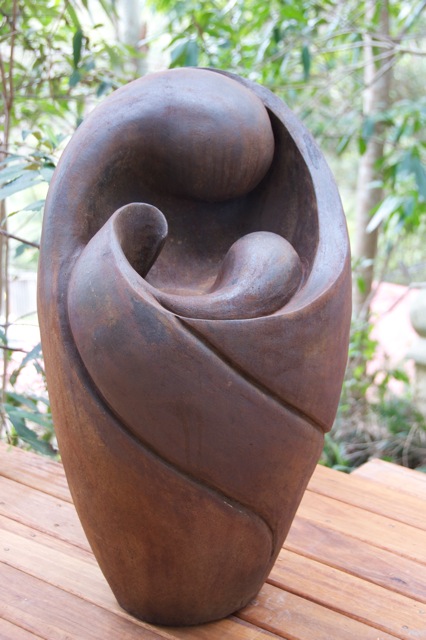
'Sanctuary' sculpture, clay, 2010
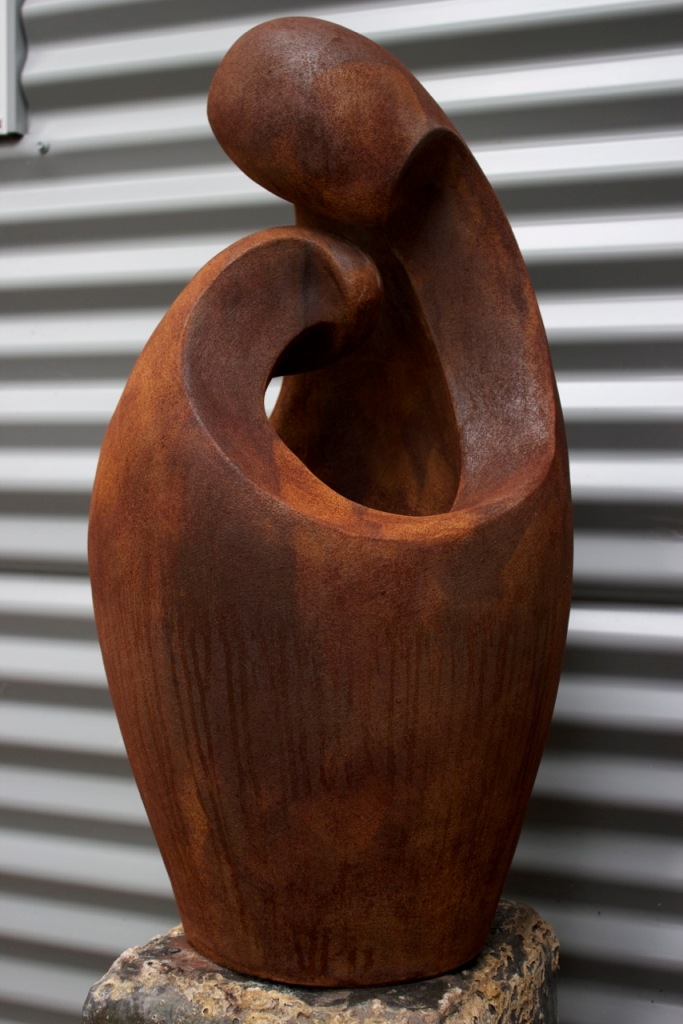
'Beloved' sculpture, clay, 2011
In January 2015 you were involved in an Ephemeral Art experience as part of ArtSpot 2015 with Shona Wilson: Collaborations with Nature. What was that experience about?
That, for me, was about beauty for beauty’s sake. When you create Ephemeral Art, you’re doing it purely for the experience of doing it, as Nature is going to take it back.
I love that relationship, as it asks me to be in the moment, it takes away that sense of expectation of myself and what I'm going to 'produce' and will someone else like it or not. It also opens up this new relationship with Nature because it's just between me and her; it's private. Maybe later on someone will come across my homage, and will be curious, and maybe not! I started to become aware of that - creating for the fun of it - when Yaramin and I would build sand-castles on the beach. And here's a secret: when I'm fossicking in the rock pools and I find something I don't want to keep, I place it carefully in a little crevice or hole in the rock, so it becomes a tiny framed relic. Ephemeral mini-alters of thanks-giving.
So what you take home is an experience?
Very much, and a photo maybe.
The other related aspect of this is that we’re Nature.
We're part of Nature, we’re not separate observers, so in doing Ephemeral Art, I am Nature, playing with my toys. It’s hard to mess with Nature when you are Nature. It's hard to dig up plutonium and fracture the earth for gas deposits and toss a cigarette butt or throw a beer can into the surf if you’re a part of the picture. That's self-harm, isn't it?
Have you thought about doing workshops along those lines – to invite people in to connect with that?
You know, that's a lovely, inviting thought. Maybe one day when I grow up! I get intimidated when people ask if I teach massage or sculpture or mosaics. I feel connected working one-to-one. That’s what I did with Yaramin for many years - collecting sea glass and shells and rubbish off the beach; teaching that respect by modelling.
And that’s how or why the Pittwater Artist Trail began?
Yes. I was sitting out on the deck, making, and I thought, ‘If I can get people trickling up my front steps to visit me, and if I had a studio, then I could be one-to-one with people and meet them, and sell items piece by piece, and that would be lovely.'
So I thought, ‘We’ll make a home studio trail’. Purely selfish! I approached Lorrie Morgan from PCA (Pittwater Community Arts) and she mentored me and told me whom to go and see and how to put the idea out and gather interest. This took six months and we then put the call out through PCA and had a brilliant response. Again it was one of those things that developed step by step and I couldn’t have told you ahead of time what would be important about it but I learned so much and it grew into this vibrant entity.
It’s still evolving.
I was four years on the committee, developing the Artists Trail with the support and vision of the evolving committee, and some enthusiastic members, and Lorrie.
For the first year's membership, 2011, anybody that wanted to, came on. It was a huge amount of work, writing and developing the brochure and signage, figuring insurance liabilities, learning about writing press releases for the open weekends and organising publicity, and getting this bunch of variously-inclined artists organised before we'd really defined what the structure of the Trail would be, or its mission.
By the second year we had a stronger sense of not fighting against what we didn't want (a non-invested membership) and moving towards what we did want (an involved and participatory membership).
By the third year the members of the committee were visiting studios to make sure they were safe and accessible, and to interview the artists who wanted to join – we began curating the Trail. We wanted to ensure there was a diversity of work, different modalities, but most of this process was about asking, ‘Do you want to be part of an engaged and dynamic Artists community within Pittwater?'
By this third year, we asked that every member take on a 'trail-task' to ensure the egalitarian nature of the Trail; shared responsibilities, shared ownership. Julie Hickson and I wrote a Charter which has this as a defining policy of the Trail. The Charter represents the Trail as dynamic and fluid, and is comprised of people that want to engage on this participatory level.
The Pittwater Artists Trail started as a grass roots idea to foster a relationship between our community and its artists. There are families and kids coming in to see how the Artists work. They get so blown away by this, are so grateful to be included into the 'inner sanctum'. That exchange, I realised at the beginning, is a fundamental part of the Trail. The conversations that take place between studio visitors and resident artists nourish both parties. If the visitor takes home an artwork, they also take home a sense of relationship with the artist - it's personal. Sometimes people buy a piece because they've met and related to the artist. The Trail invites that relationship.
I remember a father and daughter coming to visit me; they explained they did mosaics together on the weekends. They'd go to the hardware store and get tiles. The dad was poking around my shed, and he had tears in his eyes as he said to his little 8 year old, ‘Look at this Honey, we can use anything – we can use bottle caps, and sea glass, and rusty nuts and bolts...' Off they went, to inspect their garage for loot. That's such a lovely feeling, to provide inspiration for the artist in each of us.
I didn't know at the start, that that would be the core - the 'grass roots' nature of the trail; a collective of artists engaging with their community.
During our fourth year, Pittwater Council saw what we were doing was pretty good and offered us a room at Newport Community Centre for our Winter Exhibition, and supported the Trail from that time on. Recently they provided a bus for those visiting Artists on the Pittwater Artist Trail in the Palm Beach-Avalon area.
It's in its sixth year now, and is going from strength to strength. It brings people into the area and this benefits our local businesses too. Last year's Winter Exhibition at Avalon Beach SLSC was a brilliant event.
You weren’t on the Pittwater Artists Trail in 2015 though?
No, not last year and not this year either. It was a phenomenal amount of work, especially since we started curating the membership and visiting studios, and responding to calls from people wanting to join the Trail. Overseeing the rotation of members and correlating tasks, having a Facebook page, data base newsletter, managing publicity and accounts, etc...just writing the Charter took weeks. It's a lot of work for a little committee. And as the Trail renews each year, it means a new membership, new brochure, new ideas...I was often spending 20 hours a week, and not enough time in my shed. After four years, I was ready for a break.
I knew I wasn’t going to be able to come off the Committee and still be a Member without interfering, this was my baby after all. I needed to step right back. We’d also asked two additional members to come onto the Committee who were on the same page as to what the Trail is about, so the re-formed Committee: Penel, Karen, and Vicki and I spent a few months together doing all the handing over. They’re awesome – they’re passionate about the spirit of the Trail, they're tending it, evolving it...it’s in good hands. So it was easy to just step back – or off - the trail!
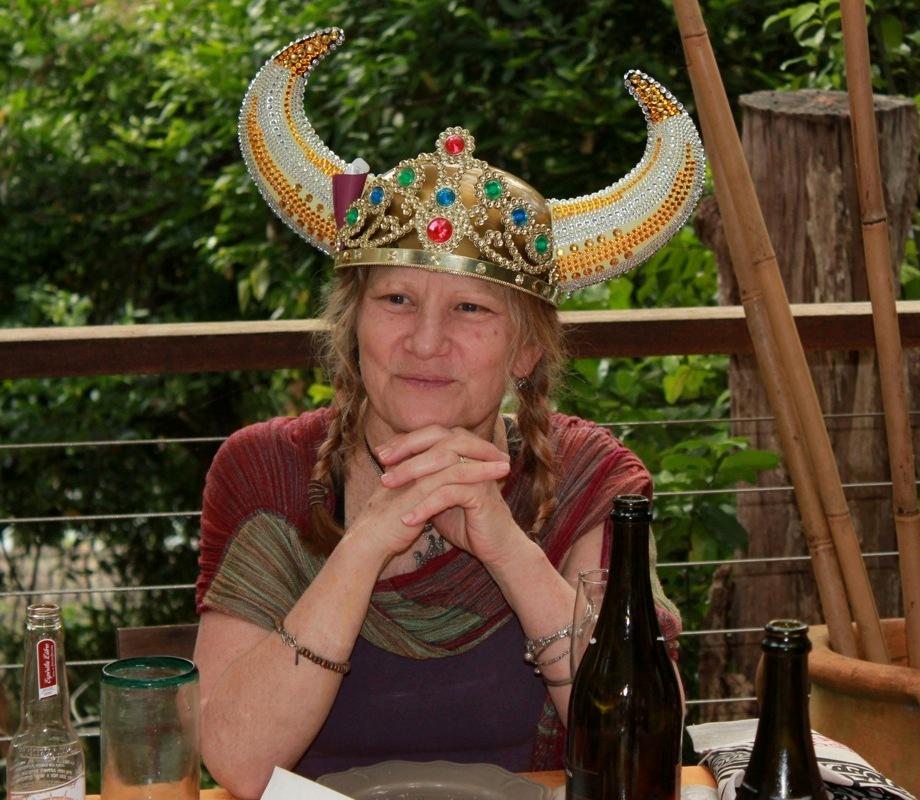
Linda, in tiara crafted by Karen Pike, Trail Committee, to commemorate relinquishment of Linda's Poohbahship of Artists Trail, December 2014.
After creating these beautiful sculptures ‘Sanctuary’ and ‘Beloved’ and your wonderful Mosaic works, what developed next and why?
My most recent pieces are what I call my ‘Pebble' Series. I’ve made four of them, they take ages to make. (Not a problem for a fiddly Virgo!) Each one has a little well that has mosaic lining it.
These are very textural, they invite touch. The two that have sold already are ones where I’ve used organic materials for the mosaics – on one I used Japanese tea twigs painted white and tiny feathers to create a nest. On the other I used tiny pebbles and tiny shells, this is called ‘Rock Pool’.
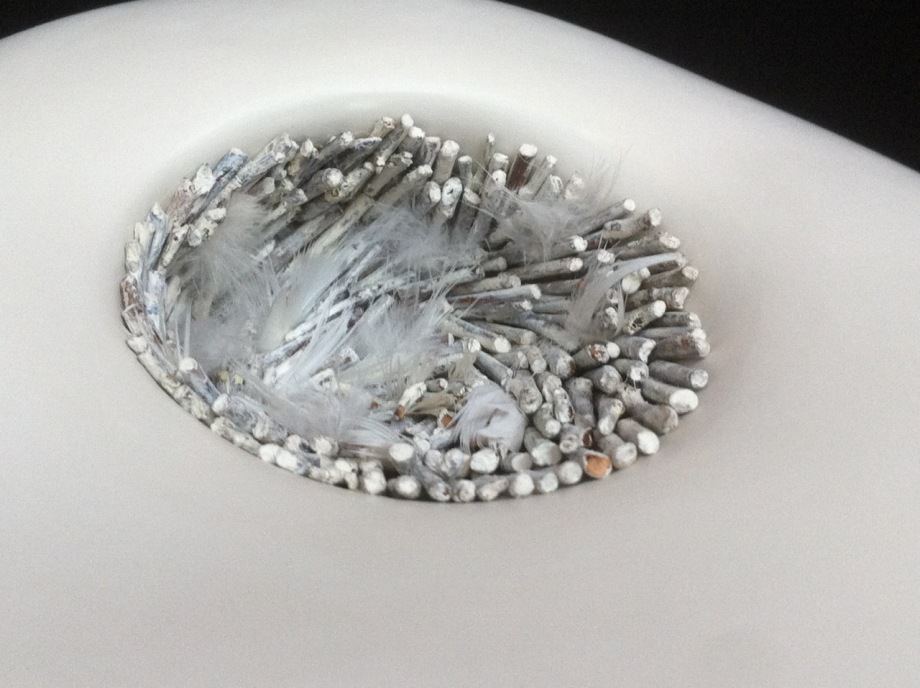
Nest Sculpture 2015: clay, bancha tea twigs, cockatoo feathers - detail
Is there a connection between the Ephemeral Art you did last year with Shona Wilson and what you created for the Avalon Art Carnival later that year?
Yes. Again this evolved. Julie Hickson, whom I know from the Pittwater Artists Trail, dragged me along to a meeting with Kendal Henry, a curator from New York who was organising the Carnival. I knew I wouldn’t get involved because it was Public Art and I’m not a public person. Kendal was showing slides of other installations he'd curated from around the world, and I thought, ‘Yes, this is fantastic, this is great, good on him, I'm outta here'.
I was turning to go, ‘Thanks Julie’, and godammit!; this image of a labyrinth just fell into my brain, like, ‘thonk!’.
Before I knew what happened I was signing up. I knew immediately I wanted to make it engaging and knew it had to be made from natural materials, that if it was left there, it would disappear back into Nature, she would reclaim it.
Susan Milne from Eramboo, (and Greg Stonehouse were the local curators of the Avalon Art Carnival), and I kicked around ideas, and came up with laying the labyrinth in the grass in Dunbar Park. I decided to use angophora branches to form the edges of the path. I love angophora branches; I collect them and beeswax them, wrap them with torn muslin. (No, really, they look better than it sounds - they're magic!) I also thought of borrowing pumice from the piles on Avalon Beach that the ocean had kicked up from recent storms. Irene Gorman, an artist I had met at Eramboo, came on board, and created a beautiful invitation card for the labyrinth, to distribute around Avalon.
Originally I thought of using tall rods of recycled reo to make 10 or 12 totems for the centre of the labyrinth. I was feverishly drilling holes through my pumice and small driftwood pieces. The idea was that there would be a bag of pumice at the beginning of the labyrinth and you would take a piece, imbue it with your wish or problem or question, walk with it to the centre, and thread it on a rod. In this way, over the two weeks of the Carnival, the rods would become soulful totems of this collaborative art work, representing everyone who walked the labyrinth. The totems would have edged the central circle where you end up, and provided a little bit of screening, a sanctuary; it would have been beautiful.
Unfortunately safety concerns meant it had to be modified.
Instead, I made a very large nest out of angophora branches, and people were invited to place their pumice talismans in there.
I had collected around 250 pieces of pumice, and it was all used up by the end of the first Saturday. We had to empty that and put it back to be reused, over and over during the two weeks of the carnival!
Lynne Czinner had two massive angophora trees that came down on her property - I'd realised pretty quickly I’d need 200-300 branches, and she kindly invited me to come and harvest. I had massive piles of angophora branches forming in my garden! - and brimming boxes of pumice in my studio, all of which have since been delivered back to the beach.
It was ‘The Barefoot Labyrinth’, which relates to other barefoot paths and parts of Avalon – Avalon is a very barefoot place, it’s one of the things I love about Avalon.
You would also be walking in grass. I thought if I invited people to take their shoes off, that would help them "ground", and it would also preserve the site.
The children really took to it, and even as I was building it, they were so curious, stopping by on their way home from school, peering over the barricade, "When will it be finished?" and getting in some early forays around the circling paths.
Labyrinths are archetypal: walking into the centre represents travelling down into your psyche. With the Barefoot Labyrinth, when you place your piece of pumice, you are engaging with your problem, you're giving it your attention and your time. Then in walking back out again via the circling, you resurface from your hero's journey. Pretty cool, huh? Or, if you're under twelve, you're making a wish and going back for more pumice to capitalise on more wishes!
Could you share a few stories around those who did enter The Barefoot Labyrinth?
Sure. I arrived there one day during the Carnival to do repairs to the nest and there was a group of high school girls in uniform with their teachers. I had cushions out so people could sit on the side, and they were all walking it and telling me how much they enjoyed having it there, both as an artwork and as a public meditation facility. They asked if it could be there permanently. I was so thrilled! This labyrinth was being inhabited!
One of the teachers was French, and she explained to me that her sister in France was hospitalised after a terrible car accident, and that she took her sister into the labyrinth every day and put her carefully into the nest. ‘Walking the labyrinth every day has helped me so much, I feel like my sister is here,’ she told me.
Some people adopted it, and when it was barricaded at night, they'd ask why, or where was the nest, had it been stolen? - not knowing I took it home for repairs once or twice.
Others were walking it every day, like a ritual. I had hoped it would engage, but I couldn't have imagined the depth at which people would take up the offer and what they got from it.
Another day I was doing repairs to the nest at the end of the day and this mum and her little three year old girl came and asked if they could walk the labyrinth while I was working.
They took their pumice stones and circled in. The mum made her wish quietly while the little girl said her wish out loud; ‘I wish that we would never grow old’. Soon the two of them were sitting on the cushions by the side, and I heard the mum say to her daughter; ‘Sweetheart, I’m looking forward to growing old, because I want to see what you’re going to be when you grow up. That’s going to be amazing...’ – she was trying to give her child this other context.
I was given so many stories...I felt deeply grateful; I’d been given so much more than I’d reckoned on. It made me realise how hungry this community is for shared ritual, we’re so ripe for it. If there was something we could create in Avalon, a labyrinth or something that provides for this ritual expression and engagement, it'd be embraced. We'll get the kids to help build it.
Are there any artists who inspire or influence you?
Well, my dad, he wasn't an artist but he was a visionary. He died a few years ago, but when I was a teenager in high school, he used to say, "Linda, you have art in you. You should use it." I didn't pay much attention then, but now, I remember that, and I love him for seeing that in me. Sometimes when I'm stuck in a process that won't open for me, I ask him for advice.
He used to call me and my younger sister "Tad Number One" and "Tad Number Two" (as in tadpoles). So I've called my art business "Tad Art" as a way of honouring and thanking him, and keeping his belief in me alive. It started with him.
Joshua Yeldham - the depth to which he exposes his heart, it takes my breath away, literally. Walking around his exhibition in Manly Gallery a couple of years ago, I had to sit down once or twice and hiccup little sobs.
Shona Wilson, I saw her mandala piece in the Powerhouse Museum, in the "Love Lace" exhibition where she’d made this 'lace' web out of bird’s skulls and ephemera.
I also feel intimidated because my little works beside these are…little. I feel like a kid pretending to be grown-up.
What are you currently working on, what’s coming up?
I want to make some of those Totems with reo that didn't get to come to life for the labyrinth in the Carnival...they'd be awesome, planted in people's gardens.
After the Totems I want to make another in my Pebble Series. It can take four months to complete one, what with my turtle-pace working style, and the labour in them. Labour of love.
This year I’d also like to venture into a little online presence – I love writing, writing is like sculpting with words, it physically feels like sculpting to me. It’s very three dimensional and the same flow from inner to out. So maybe a blog or a website; I'm just figuring out where to begin…
How can people access your work if you’re not on the Trail?
Please come and visit me in my home studio - I'm still open every Friday, 10am - 4pm at 3 Burrendong Place, Avalon.
What is your favourite place in Pittwater and why?
I've lived for about twenty years in Avalon, and there are so many things I love about it. Before we moved here from the lower North Shore, we spent weekends driving through the streets of every suburb starting from Cromer, and heading progressively northwards. We would highlight the streets we liked in the street directory. (Spot the two Virgos!) The day we got to Avalon, we had lunch in a cafe in Avalon Parade, and my partner, Robin, and I looked at each other, and said, 'This is it.'
I love the rock pools at the northern end of Avalon Beach. The grey and mauve colours of the rocks feel like home. The smooth little stones in the pools inspired my current 'Pebble' series of sculpture. The textures and layers in those pools are the private universes of myriads of tiny marine creatures.
I love that it's called 'Avalon'. We live in a place named for an Arthurian legend; an island of mystical powers and renewal.
To live on the beaches is a gift beyond measure. I love being on my boogie-board, sliding down the face of a glassy wave. It's very uncool but I still can't stop myself screeching for happiness when I get a flying ride.
I love the angophoras that inhabit Pittwater...their shedding bark, their gnarly branches, their changing colours. We painted the walls inside our home to match the angophora trunk when it's in its 'mauve' season.
I love having the backpackers from the hostel in the streets - gaggles of cheery-faced, mostly Spanish-speaking youths heading down for their volleyball on the beach...the Argentinian conducting a yoga class for fellow travellers in the park...the backpackers' brings us other cultures, adventurers, diversity. Robin is from Uruguay, so he's constantly accosting the South American contingent for first-hand news from his homeland.
I love the S-bends; the constantly-changing community news and greetings and occasional proposal of marriage on the power poles. Talk about the bush telegraph! I nearly drove up the back of the car in front of me last week, reading about the tiler and the teacher going to the chapel.
And the fact of the S-bends - you know you really want to be in Avalon (or Whale Beach or Palm Beach) if you stare down those bends on your daily commute. It's like the right-of-entry quest.
What is your ‘motto for life’ or a favourite phrase you try to live by?
I have Leonard Cohen's words scrawled on my chalkboard: "There is a crack, a crack in everything. That's how the light gets in." That, for me, speaks for the human condition. It helps me to remember the humanity and nature in 'imperfections', and the absurdity of the quest for 'perfection'. We'll do anything to avoid or deny our "cracks" in our protection of image, but it's our wounds that shape our humanity, our hearts. Carl Jung called it our "shadow". It's in sharing our sadness, anger and vulnerability with each other that we experience empathy and connection. Perfection will never move your heart, or comfort your soul, or make you feel like you belong.
I think it's the artists (i.e. Leonard Cohen!) that often lead the charge to explore and express that shadow side of our psyche. And the beauty that comes from that courageous process: the cracks that open to the light.
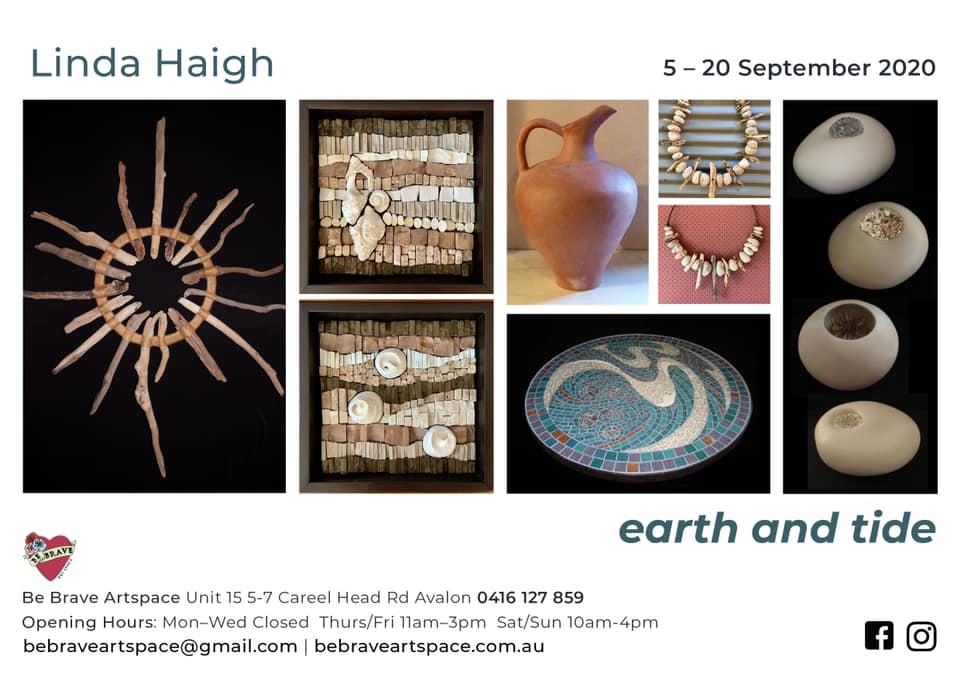
Barefoot Labyrinth
Linda Haigh and Irene Gorman
Barefoot Labyrinth
The Barefoot Labyrinth, laid in the grass and edged with angophora branches, extends an invitation to take a few minutes for contemplation as you follow the path to the centre.
Labyrinths are archetypal...by building and walking them, we participate in a very ancient ritual that can be experienced as magical, (especially if you're a kid!) meditative, transformative, playful, and healing. This builds connection with our intuition, our collective human wisdom, and our Mother Earth. Or, if you like science, it enhances right brain activity.
You can carry a dream or a question into the Barefoot Labyrinth, perhaps find a message, and leave a talisman to add to a communal testament of everyone who has walked it.
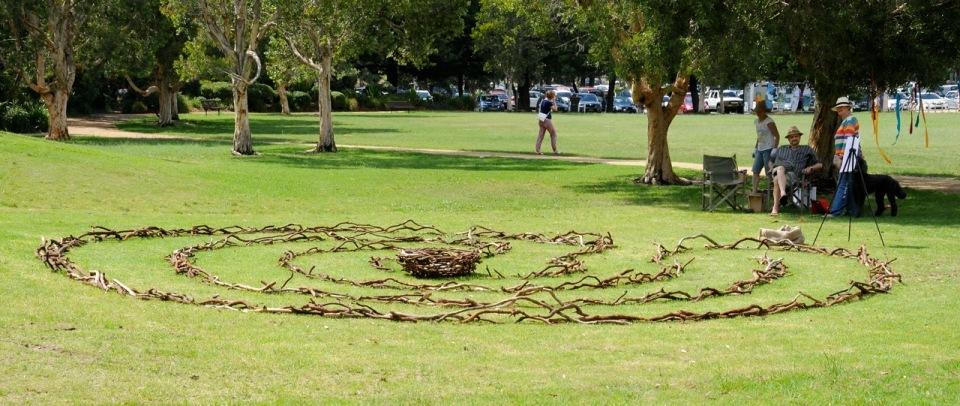
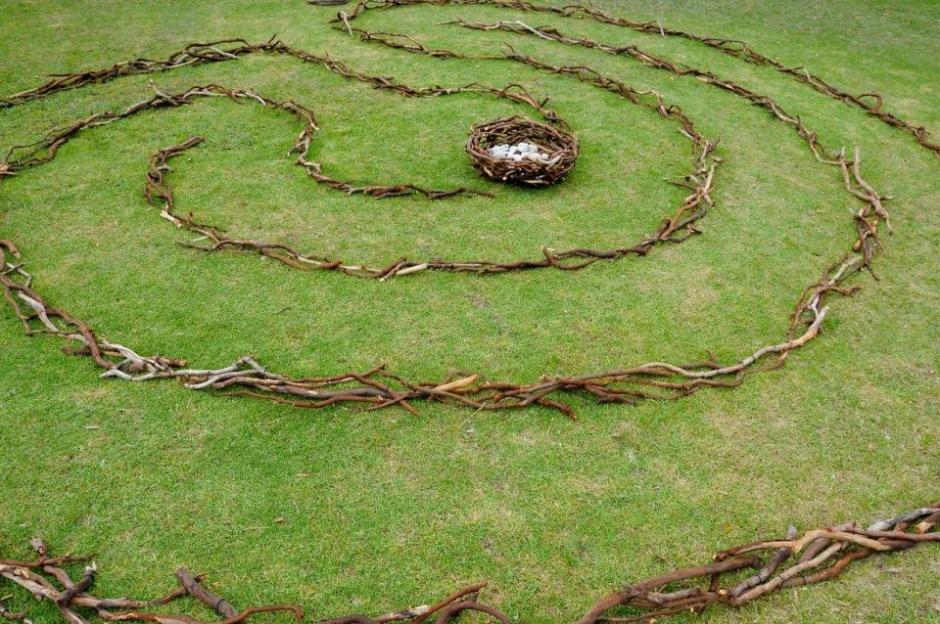
Barefoot Labyrinth Photos by Adrian Boddy - Adrian Boddy Photography.